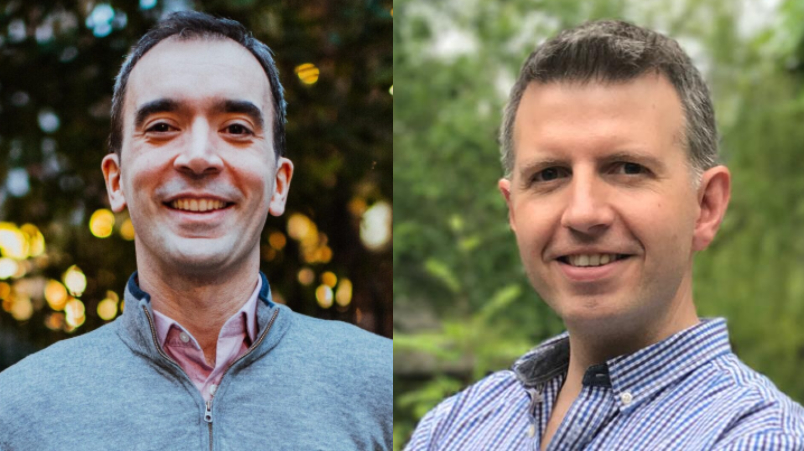Green team: Australia's TV networks have 'net zero' blueprint with UK production carbon calculator, virtual studios, exec bonuses tied to net zero targets say ITV sustainability chiefs

We can't sit around waiting for zero emissions planes, trains and boats. It's not going to happen within the next eight years. So if we want to get to our 2030 interim target, we need to work differently. We need innovation.
The world’s biggest ad holdcos – and Australia's top brands – are racing to build media carbon calculators and metrics to allocate spend based on publisher carbon footprints, but locally we're way off the pace. The UK TV industry is a decade ahead, using an industry standard calculator for production emissions. Australia could use the same tool, but seems to be ignoring it. "There's a framework to follow, literally. It's a gift," say ITV Studios' UK sustainable production chief Phil Holdgate and sustainability manager Jeremy Mathieu. As brands eye their advertising supply chain carbon footprints, ITV's green team are juggling virtual production, no fly zones, remote live hubs and recycled sets. Here, ITV produces The Voice, The Chase, Love Island and Shaun Micallef’s Mad As Hell – with more shows to come, and greater investor pressure on networks, agencies and brands is incoming.
What you need to know:
- ITV’s Senior Sustainability Manager Jeremy Mathieu and ITV Studios’ Head of Production Sustainability Phil Holdgate, think Australia's TV networks and production companies can lift the decarbonisation blueprint and resources put together by the UK industry.
- ITV has committed to net zero by 2030, and Mathieu says its "Scope 3" emissions – those in its broader supply chain – are the hardest to decarbonise. It aims to reduce those by 28 per cent by 2030.
- Locally, ITV Studios produces The Voice, The Chase, Love Island and Shaun Micallef’s Mad As Hell.
- The UK has been using the 'albert' carbon calculator for more than a decade to calculate the impact of TV production. Virtual production, less travel, all renewable energy and remote live broadcasts are a few ways emissions can be dramatically reduced.
- ITV has already produced one show in Australia using the blueprint – proving it can be done.
We're starting to have a conversation around the responsibility of agencies and media around the uptick in consumption that advertising creates
Remote carbon control
Virtual production, remote live hubs, slashing travel, all renewable energy and executive bonuses linked to carbon targets are all are part of a blueprint that UK and European TV companies have created for reducing production emissions, developing industry-accepted calculators and ideas. Australia's networks and production companies should lift that blueprint or risk losing international brand dollars seeking decarbonised supply chains.
ITV Studios Australia, the local arm of the global company behind shows like The Voice, The Chase, Love Island and Shaun Micallef’s Mad As Hell, will be part of ITV’s carbon reduction push. Nurses, a local show produced for UKTV by ITV Studios Australia, was made using the UK's framework, proving that it can also be done here.
The company is aiming to reach net zero carbon emissions by 2030, produce zero waste, and reduce 'Scope 3' emissions – those in the company’s broader supply chain, i.e. the carbon produced as a result of people watching ads on devices – by 28 per cent over the same time, from a 2019 baseline. ITV plans to offset the rest.
“Production activities require more of a transformation of the sector,” Jeremy Mathieu, ITV’s Senior Sustainability Manager, told Mi3.
“What you guys [in Australia] need to do is accelerate that by finding the right people in the right positions with the right mindset.”
Phil Holdgate, Head of Production Sustainability at ITV Studios, said: “There’s a framework to follow. Literally, it’s like, ‘here are the tools, here’s how it can operate, here you go’. It’s a gift.”
There’s a framework to follow. Literally, it’s like, ‘here are the tools, here’s how it can operate, here you go’. It’s a gift.
Late mover advantage
Australian media companies can gain from international lessons, Mathieu said. At ITV and other European firms, executive bonuses are partially tied to emissions targets, which tends to focus minds. But he believes reducing carbon is everyone’s responsibility.
“The idea is to move from sustainability being something nice that you do on top of your job – if you're passionate about the stuff – towards making it part and parcel of everyone's job. My motto is 'climate action is everyone's job at ITV’, and we're actually working towards that by putting it into people's objectives [and pay structures],” he said.
KPI-ing staff is something Australian media will likely need to adopt.
Locally, The Guardian has committed to net zero by 2030 – and JCDecaux claims it is already there. News Corp aims to reach net zero by 2050, but Nine, Seven, Paramount ANZ (formerly 10 ViacomCBS), Southern Cross Austereo, and oOh!Media are yet to announce hard timelines or targets.
Major advertisers like Telstra and GroupM’s CEO Christian Juhl, boss of the world's biggest ad buyer, have said they’ll direct ad dollars to publishers, agencies and tech providers that align with their decarbonisation goals. Mathieu hasn’t seen that happen explicitly in the UK yet – but he says there is an “industry change” going on.
“I think what we're more likely to see is ... more conversations growing around this sector, which means, over the medium term, media companies must put in place commercial strategies that help them manage the transition,” he said.
“The key thing is that we're starting to have a conversation around the responsibility of agencies and media around the uptick in consumption that advertising creates," added Mathieu. "There's a big push from agencies, media and creative, because they they want to be part the solution not the part of the problem."
Albert calculator, fast follow
The BBC launched its 'Albert' carbon calculator in 2010 to help TV companies work out the environmental impact of their productions. Then BAFTA took over management. “That was the key moment right from the start, because it created a forum where all the major players in the industry could sit together and discuss sustainability,” Mathieu said. That continued until around 2018, when the notion of ‘net zero’ emerged. That is, trying to become carbon neutral through consumption of clean energy, energy efficiency and emissions reduction, and offsetting carbon emissions through things like planting trees and land management as a last resort.
“Nobody knew about net zero before that. It didn't exist. Then suddenly the broadcasters mostly jumped onto it and said, 'okay, this is the gold standard now',” Mathieu said. “But because we had spent years educating people, talking about this stuff, having that shared groundwork, it meant that broadcasters went very fast from that point on.”
Production polluters
ITV is split into two divisions, Media & Entertainment, the UK broadcaster and commercial sales, and ITV Studios, which covers circa 60 production companies in 13 countries. ITV holds the rights to Love Island but has been filming different national programmes in one location to make the process as efficient as possible.
“One thing we're trying out this year is the idea of a shared hub. So one of our versions (of Love Island) is based on a Spanish island this year,” said Holdgate.
“We've built something once, but we're using it many, many times… that means we also get consistency of our product. Everyone's seeing the same set design, the same logos, the same commercial opportunities, the same sort of technical infrastructure as well. The look and feel of Love Island [stays consistent], we're protecting our assets as well.
"So there's loads of additional benefits that I think we can focus on those as much as, 'hey, we're also trying to save planet, guys, come on'. And that's a really difficult thing for people to turn their noses up at.”

MELS Studios in Montreal, Canada, has replicated the Paris skyline at sunset in their studio using virtual production.
Virtual production, remote live hubs, transport, transmission
When reporting carbon emissions, companies usually report Scope 1, Scope 2 and, in some cases, Scope 3 emissions. The first and the second are hard to do credibly, but relatively straightforward, because they relate to the emissions as a result of business operations. Scope 3 – which covers up and downstream emissions, e.g. the carbon footprint of an ad viewed on a TV or tablet and the energy/carbon resulting from the power used to show that ad – is a challenge that very few businesses have mastered. For now in Australia, Scope 3 emissions reporting is not mandatory. But production footprints lies within reportable emissions – and alongside transmission – which represents a major chunk of what publishers can directly control.
Which is one of the reasons virtual production, harnessed by Disney for The Mandalorian alongside Epic Games' Unreal Engine – is going to be huge, reckons Holdgate. Also because the wins go way beyond carbon.
“You don't have the materials, you don't have the waste. I won't quite call it a silver bullet, but it's an opportunity to achieve great creative results that the viewer really enjoys watching, but with a much, much smaller footprint,” he said.
“I don't think we've even scratched the surface of virtual production yet… there's some great examples." He cites "a couple of characters on a rooftop scene in Paris at Sunset" by way of example.
"Trying to do that on location is incredibly challenging. So it was recreated at a virtual studio, but the set rooftop was a built set, two feet off the ground." said Holdgate.
"Straightaway from a health and safety perspective, that was really easy. And that 'magic hour' that producers love, you could literally have it all day long. They could move the Eiffel Tower wherever they wanted it in the background, perfectly in shot. And that was all done in Vancouver, in Canada." he said. "They didn't set foot on a plane.”
Decarbonisation driving strategy
Making 'net zero' an agenda item for the business and shareholders is now influencing stories and culture. Late last year, major UK broadcasters and streamers signed up to the Content Climate Pledge, an initiative where TV firms commit to explaining decarbonisation to audiences.
“ITV has a big kind of focus on our social purpose and the idea is to be 'more than TV' – we want to shape culture for good,” Mathieu said.
“Now we're working on developing the insights to work out how we can do that: How can we do that through a storyline in a soap? How could we do that through more current affairs programming? How do we find the right interventions to help the audience have a better, positive impact from a cultural angle? That's something that falls outside of the net zero 'pure remit'. But we recognise it as our biggest opportunity, our biggest responsibility. And that becomes a very interesting creative conversation as well.”
Ultimately, said Holdgate, publishers need to grasp the nettle and start doing things differently if they are serious about actually decarbonising, rather than just talking about it and setting long-term goals.
"We can't sit around waiting for zero emissions planes, trains and boats. It's not going to happen within the next eight years. So if we want to get to our 2030 interim target, we need to work differently. We need innovation."
Given Australia's carbon laggard status and geographical isolation, perhaps that blueprint might be worth a look.
